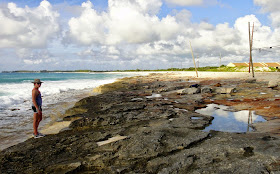“Wherever you go, you should always pay close attention to your environment because you never know when you could come across something really cool," says Emory graduate Meredith Whitten, shown basking in the winter sun of the Bahamas.
By Carol Clark
Nobody knew better than Christopher Columbus that knowledge and experience, guided by luck and the right conditions, are key to making a discovery – even an accidental one. On October 12, 1492, he found what he thought was a shore of the Indies, but was actually an island in the Bahamas that he christened San Salvador.
During the winter break of 2013, Emory senior Meredith Whitten was on San Salvador for a study abroad trip, part of an environmental sciences class called “Modern and Ancient Tropical Environments.” Whitten had already visited the island when she took the course as a sophomore, and she was returning as a teaching assistant.
“It’s a great course because you get to go back into the past by looking at the rocks,” Whitten says. “It’s cool to see how the Earth has changed and also stayed the same.”
“She brought a lot of knowledge and experience to the group,” adds Anthony Martin, the professor who developed and teaches the course. Martin is a paleontologist who specializes in trace fossils: Tracks, burrows and other signs of ancient life.
“We go around the entire island in a big, open-bed truck,” Martin says of the field portion of the class. “We stop at known fossil sites, and at interesting modern environments to imagine what they might have looked like in prehistoric times. I call it ‘The Magical Mystery Tour.’”
Whitten stands by the fossil track site, the pale patch of rock next to her feet.
On December 30 of 2013, that tour stopped at a shoreline site where Martin noticed an outcrop of red rock. “I wanted to explain to the students about palesols,” Martin says. That paleosol, or fossilized soil, originated as dust from the Sahara desert. Not unlike Columbus, that dust was carried across the Atlantic by trade winds and deposited on San Salvador. “Some of that dust had iron minerals that got oxidized and, like the red socks in your wash, colored the sediment,” Martin says.
While he was explaining all this to the students, Whitten was looking at a patch of white rock being lapped by the ocean. “I could tell that the rock was recently exposed because it was so white and hadn’t been weathered,” Whitten says. “There must have been some storm surge that had recently broken off the top layer.”
A wave had just splashed the rock, darkening its features. And it was late afternoon, so the light slanted at just the right angle to make details in the rock’s surface pop out. Still, only someone who knew what to look for could have noticed the faint impressions.
“I saw the shapes and called Dr. Martin to come over, I thought I’d found fossilized bird tracks,” Whitten recalls. “I was sort of surprised when he looked at them and agreed. It was very cool and exciting for both of us.”
It took knowledge, experience and a careful eye to spot the faint impression of a partial bird track.
The field class turned into a real-life lesson in how to document a fossil find.
Whitten and Martin are co-authors of a paper on the two partial bird tracks, to be published in March by the journal Geologica Acta. The avian footprints are the first known vertebrate trace fossils on San Salvador, and only the second example from the Bahamas. They date back about 120,000 years, to the Pleistocene Epoch, and match the size and form of tracks made by modern-day gulls.
“Fossilized tracks like these give us a better idea of what previous environments were like,” Whitten explains. She notes that it’s likely shorebirds were walking around the upper part of a beach, near the dunes, when the tracks got cemented in carbonate sand, buried and preserved. “Understanding past coastal environments, and how sea levels have changed, could give us insights into what may be occurring as we look ahead at climate change.”
After graduating from Emory last May, Whitten decided to take time off as a dive instructor in the Bahamas before entering graduate school with the aim of a career in managing fishery policy.
“It was so fun to have a day in the field turn into so much more,” Whitten says of her experience in the Emory class. “Wherever you go, you should always pay close attention to your environment because you never know when you could come across something really cool.”
Columbus couldn’t have said it better.
Photos courtesy Meredith Whitten
Related:
Tell-tale toes point to oldest known fossilized bird tracks from Australia




No comments:
Post a Comment